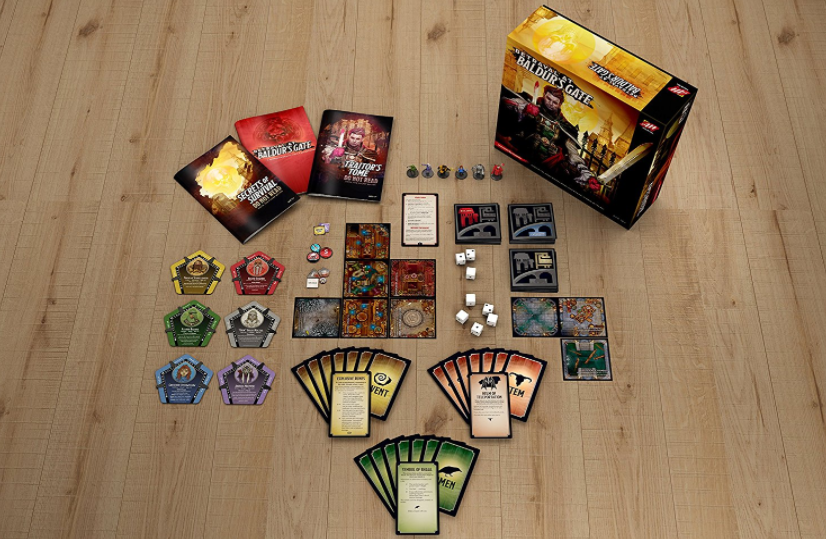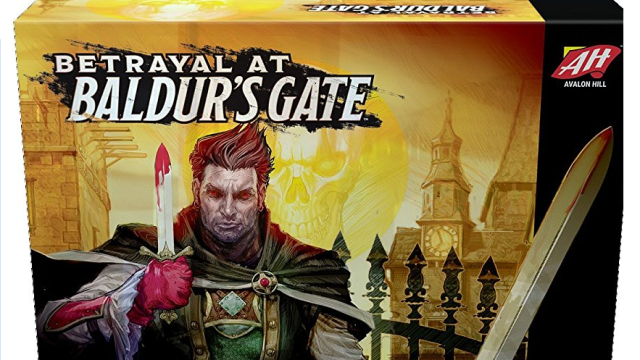Last week, Wizards of the Coast reimagined their classic horror game Betrayal at House on the Hill in a Dungeons & Dragons high fantasy setting. Back in 2004, Betrayal captured the curiosity and fear that comes with crawling through a haunted mansion with mechanics that brilliantly mirrored its horror theme. Slowly and deliberately, players map out a mansion by opening its doors to any number of threats and mysteries, represented by flipping over random room tiles. As the game progresses, the mansion is revealed as a sprawling cluster of rooms that eventually become the hunting grounds for some ghostly danger out for blood.
Betrayal at Baldur’s Gate
I was sceptical that Betrayal at Baldur’s Gate would work, and that a design so clearly inspired by horror would land gracefully as a sword-and-sorcery adventure game. Yes, dungeon-crawling is a D&D trope, but I wasn’t sure what would become of D&D tropes such as levelling up, helping others, questing with a cause, or gathering loot. Though a few small things feel awkward in the fantasy context, overall the game is an inventive twist on both D&D and Betrayal.
Betrayal at Baldur’s Gate has players move through the streets, buildings and catacombs of the cursed city of Baldur’s Gate. Each player chooses an adventurer, such as the dwarf fighter Aldan Pyrite, the warlock drow Lia Faen Tlabbar, the human bard Miska Silversong and so on. Each has their own strengths, weaknesses and a special power (a new feature in this fantasy iteration). Moving around the city, the adventurers reveal location tiles from a stack; in those locations, they might encounter an item, an event or an omen. After the players unearth several omens, it’s likelier that they will initiate a “haunt”, one of 50 scenarios that depend on the omen’s location and appearance — perhaps a homunculus in the sacrificial chamber or a whispering skill near the cursed statue.

During the haunt, the game’s dynamic shifts from cooperative exploration to something more sinister and strategic. Often, one player will be forced to turn on their party — perhaps they have become a lich and sick their skeleton minions on their former friends, or a mind flayer in disguise who seeks to save their elder brain from players’ bloodlust. Combat is played out with simple dice rolls based on adventurers’ stats. Often the traitor wins if they kill everyone else, and vice versa, although there’s quite a few varied win conditions across the 50 haunt scenarios. That makes Betrayal at Baldur’s Gate eminently replayable.
In most ways, Betrayal at Baldur’s Gate cleverly twists D&D‘s gameplay into Betrayal‘s horror design. The human bard’s “bardic inspiration” ability grants an extra point to any player’s roll when they’re within three rooms of her. The dwarf fighter’s “protection” ability lets him take damage in lieu of another player, a fun take on “tanking” in a board game. Architecting a well-rounded party, a staple of D&D, will benefit players here, too, so adventurers can support each other during the haunt. Also very D&D was the frequency of strong magical items. Despite how unlikely it would be in D&D for four players to encounter four different magical relics in four separate rooms at once, here, it gives players opportunities to mid-max and balance stats for optimal combat, a core D&D experience.
The original horror game’s Lovecraftian elements certainly benefited the “kick open the door, loot the room” D&D model here, too. I’m so glad that Wizards of the Coast kept Betrayal at House on the Hill‘s “sanity” stat here, despite its absence from D&D‘s ruleset. From a plot standpoint, the stat makes sense: As the players encounter increasingly terrifying mysteries, they can lose Sanity points, which in turn can affect their ability to keep their cool in important moments that require levelheadedness. “Sanity” adds a refreshing psychic element to each game’s story.
Unfortunately, Betrayal at Baldur’s Gate‘s plot stumbles over itself elsewhere. It was hard not to wonder why the players were here. In your typical Lovecraftian world, a deep yearning for the dark unknown pulls players toward haunted houses, and when the supernatural appears, it’s a generic expectation. In Betrayal at Baldur’s Gate, players know that the city is cursed and they must banish evil. But what brought them here? What is the tension that breaks to spawn the haunt? What do players stand to gain by defeating the evil? Surely not loot or experience, like in D&D.
Betrayal at Baldur’s Gate could have rethought a few of Betrayal at House on the Hill‘s mechanics to better suit its needs as a fantasy tabletop game. In House on the Hill, discovery always felt like an end in itself, whereas here, the game’s emphasis on item acquisition — very D&D-esque — is reflected in its relatively low count of “omen” cards outside the catacombs. Players must hunt for the supernatural by diving into the catacombs to move the story along, which makes sense from a plot perspective, but it means that the front half of the game is all about gathering items. For me, that dragged. It doesn’t really make sense in a D&D game to meander around, hoping to stumble upon scattered relics and only then go down to the spooky place to kill the evil thing, and it doesn’t make much sense here.
The best thing about Betrayal at House on the Hill was its all-encompassing dedication to horror in its look, in its mechanics, and in the stories that spawned out of each play session. Nothing about the game breaks character. Betrayal at Baldur’s Gate does not present the same all-encompassing vision of exploring a sword-and-sorcery fantasy land and fighting evil, and yet, it’s still a blast to play, for the most part, because the original game is so damn good.

Comments